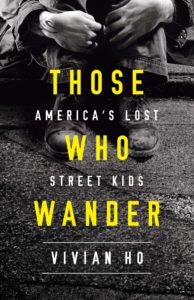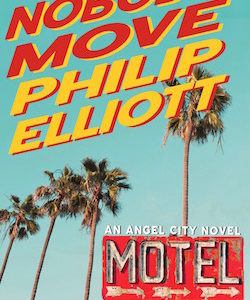When Reverend Larry Beggs founded Huckleberry House for Runaways in response to the growing underage runaway population flocking to San Francisco in the 1960s, he realized well before most that when kids ran, it was not just what they were running from, but what they were running to. These “lost children with windy feet,” as one of the kids once described herself to him, were just searching for something better, searching for somewhere to belong.
 More than fifty years later, this still rings true for the transient youth who continue to roam through the streets of San Francisco. Their actions may seem reckless, their decision-making rash, but therein lies the folly—and hubris—of youth. Just like your hometown teenagers trying beer for the first time, like the youth who toilet-paper and egg their neighbors’ homes on Halloween, they go forth believing they are invincible, that they are beyond consequences, that nothing can get in their way.
More than fifty years later, this still rings true for the transient youth who continue to roam through the streets of San Francisco. Their actions may seem reckless, their decision-making rash, but therein lies the folly—and hubris—of youth. Just like your hometown teenagers trying beer for the first time, like the youth who toilet-paper and egg their neighbors’ homes on Halloween, they go forth believing they are invincible, that they are beyond consequences, that nothing can get in their way.
For all the suffering they endured to drive them to the streets, and for all the further misery they experience once they get there, so many still carry with them a fragile innocence behind their hardened and dirty exteriors. Sometimes all the money they get comes from the kindness of strangers, so as hurt as they are or have been in the past, they haven’t given up yet on believing in goodness, in a better life. They want more but do not yet know what that means. And so they search, leaving all they know in order to not just find their purpose, but understand it. They search, just like every other young person in the history of mankind. They search, just as twenty-three-year-old Audrey Carey was searching, when, on a whim, she bought a plane ticket to San Francisco one month before her murder. “Et peu importe la destination, c’est le voyage qui compte,” she told her mother, according to La Presse.
“Whatever the destination, it’s the journey that counts.”
***
Audrey Carey arrived in San Francisco in September 2015 with a backpack full of camping gear and $600 in cash.
At twenty-three years old, the dreamy-eyed Quebecois traveler was embarking on her first solo trip, searching, like so many others her age, for not just adventure, but herself. Her mother, Isabelle Tremblay, told local Quebecois media that Audrey had recently dropped out of the University of Sherbrooke after realizing she didn’t want to spend the rest of her life as a lawyer. “Do you not think that it’s a little stupid that the world asks what we do in life?” Audrey asked her mother, according to La Presse. “Ask me what I am!” Following a hard summer planting trees in Abitibi, surprising and arduous work for a girl who grew up comfortably in a small city outside of Montreal, Audrey had declared, “I do not want to work between four walls.” But what that meant, she did not know, and she soon found herself on her way to San Francisco.
It must have been both a relief and a thrill for the kindhearted girl to meet so many youth in San Francisco going through that same sort of soul-searching as she was. The city’s history as a beacon for the counterculture meant that, fifty years after the Summer of Love, its streets and leafy parks still served as a hub for the homeless, the houseless, the drifters, and the restless. She emailed her mother on September 25: “Je crois que je trouve tranquillement ce que je cherche”—“I think I am gradually finding what I am looking for.”
On the day she met her murderers, sitting near the windmills at the base of Golden Gate Park with their own bulging backpacks and unwashed hair, she must have felt like she was encountering three more like souls.On the day she met her murderers, sitting near the windmills at the base of Golden Gate Park with their own bulging backpacks and unwashed hair, she must have felt like she was encountering three more like souls. There was Sean Angold, a tall, lanky boy with piercing blue eyes and a dark shock of hair falling into his face; Lila Alligood, a girl with tangled blonde dreadlocks and meth sores on her round cherubic face; and her boyfriend, Haze Lampley, a scruffy-faced and dreadlocked boy with an intensity that failed to meet his eyes. Like her, they were just passing through—somewhere in Oregon, there was a cabin where they planned to start a weed farm and live out their days once they grew tired of wandering and got out of San Francisco.
It was October 2, 2015, an uncharacteristically warm day in San Francisco. Summer in the foggy city doesn’t really strike until late September, when for just a few weeks at the beginning of autumn, heat overtakes the usual cool gray that blankets these hills, bright sunlight pushing through the fog and the chill. City dwellers abandon the light jackets that they always carry with them and flock to the city’s many outdoor spaces, and the entire region gets overtaken by an endless summer vibe.
According to Sean Angold’s testimony, Audrey was shy at first, unsure of how to approach the trio and make the connections she sought in her travels. She passed them on her way to buy beer as they shared a bowl of crystal meth near the windmills in Golden Gate Park.
“Hey, what’s up? Want to have some fun?” Haze said they asked her. And she joined them.
***
We will never know for certain what happened during that murderous, drug-fueled week in 2015 that resulted in two killings and three arrests. In my years reporting on crime and mayhem, sitting in on murder trials and poring over court documents, I have learned that truth is relative—there are only the facts and what you believe those facts say, and that varies from person to person.
In any case, we have several accounts of what happened that week: Sean Angold’s account, Haze Lampley’s account, Lila Alligood’s account, and what the investigators and prosecutors believe. Sean was the one to break first, sitting in an interrogation room in Portland, Oregon, and spilling to detectives from both Marin County and San Francisco the details of the murders. His account paints him as the less culpable of the three, which could either be read with a jaded eye as being a bit too convenient, or be accepted as a reasonable explanation for why he talked when the other two did not. But the many investigators involved in the case stand by his account as the truth, pointing out that Lila corroborated his telling of the events. At first, Lila tried to pin both killings on Sean, in an effort to protect her boyfriend, but eventually she cracked after intense questioning. Haze thinks she gave in because she was scared; however, she later bragged to a cellmate in Marin County Jail about the killings, following Sean’s narrative to the end. The cellmate, Pamela Bullock, who came forward with the information in hopes of reducing her own sentence, said that Alligood referred to Carey as “the bitch,” Marin County Sheriff Detective Scott Buer testified. “All of a sudden, Lampley jumps up and shoots her and there is blood and brains splattered all over,” the cellmate said Lila told her.
According to Haze, he and Sean met during one of Haze’s many sojourns in San Francisco, in July 2011 in Buena Vista Park, just weeks after my fated meeting with Dave Thompson. Haze was still a teenager and looking for a quiet spot to ingest some methamphetamines in Buena Vista Park. “Street kids call it Tweaker Hill,” he said. “If you want to do meth or anything on Haight Street, you go there.” And under the park’s leafy cover, he encountered Sean, who went by his “dirty kid name” of Smalls—Haze’s dirty kid name is just Haze, while Lila’s is Māhealani, a remnant from her time living with her family in Hawaii. That day, Haze and Sean gave each other a nod of acknowledgment and would probably have just ignored each other had it not been for a passing policeman doing a walk-through of the area. In having to relocate to another spot, they struck up an easy friendship, bonded mostly by their drug use, and spent the next three days together.
In her lilting Quebecois accent, Audrey thanked them for being her friends, one of her final acts before she was killed.I know from the little that Sean told me in brief phone calls before he stopped responding to my inquiries that his upbringing was not much different from what Haze experienced. Investigators said his family essentially “lived as gypsies” during his early years, before he and his two younger sisters were taken away from their parents in California and entered into the foster care system. His father had been a drug addict and his mother in trouble with the law, Sean said, but his time in foster care was not much of an improvement. He bounced from home to home, some as far out as Texas, before he was adopted by a family in Phelan, California. He balked at reliving the abuses he suffered in foster care, but he did share that one foster parent once almost drowned him as a punishment for getting suspended from school, and that the family that adopted him was psychologically abusive. He was diagnosed as manic-depressive and got into enough trouble as a minor that he was sent off to a group home at sixteen. He ran away, straight into the world of crystal meth.
“There was always this itch in the back of my mind that if I didn’t stop doing drugs, something bad would happen,” Sean said. “Well, it happened. Unfortunately, it happened in a big way.”
Haze said he and Sean never really hung out again after that first meeting, though in the insular world of San Francisco street kids, they must have passed each other on occasion. But the next time they spent any significant amount of time together, their bond would grow beyond that of drugs to one of bloodshed.
According to Sean, it wasn’t long after Audrey joined the three that they decided to rob her. They shared cigarettes and drank beer before heading to a nearby 7-Eleven for pizza. “She was foreign and possibly had money,” Sean would testify later in court, a Southern twang, a remnant of his time in Texas, still present in his voice. He never specified whose idea it was in the first place, but the plan was to rob her and nothing else, he said.
They whiled away the afternoon together—Sean didn’t go into detail about what they did, but her autopsy report found traces of methamphetamine and marijuana in Audrey’s system—and returned to the park as night fell, near where they had first met by the windmills. In her lilting Quebecois accent, Audrey thanked them for being her friends, one of her final acts before she was killed.
____________________________________________

















